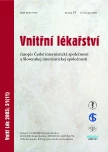Type 1A diabetes mellitus and autoimmunity
Authors:
D. Vrlíková; M. Mokáň
Authors‘ workplace:
I. interná klinika Jesseniovej lekárskej fakulty UK a Martinskej FN, Martin, Slovenská republika, prednosta prof. MUDr. Marián Mokáň, DrSc.
Published in:
Vnitř Lék 2005; 51(11): 1297-1302
Category:
Review
Overview
Type 1A diabetes mellitus presents the most frequent part of type 1 DM. This disease is caused by an autoimmune destruction of pancreatic β-cells. Genetic, autoimmune and environmental factors are responsible for the development of type 1 diabetes. The most important genes that determinate te development of the disease are genes of Major Histocompatibility Complex (MHC). There is evidence that viral infection acts as a triggering event of autoimmune reaction. The immune response to a microbial determinant would cross-react with host tissues and results in an activation and proliferation of T-lymphocytes that cause destruction of pancreatic β-cells.
Key words:
type 1A diabetes mellitus - HLA-alels - T-lymphocytes - pancreatic β-cells
Sources
1. Acton RT. The major histocompatibility complex. In: Rich RR (ed). Clinical Imunolgy, Principles and Practice. London, Edinburg, New York, Philadelphia, St. Louis, Sydney, Toronto: Mosby 2001 : 6.1-6.13.
2. Buc M. Klinická imunológia. Bratislava: Veda 1997.
3. Buc M. Imunológia. Bratislava: Veda 2001.
4. Buc M, Shawkatová I. Imunopatogenéza diabetes mellitus 1A. J Čes Slov pediatria 2002; 57 : 299-305.
5. Černá M, Žďárský E, Anděl M. HLA-systém a diabetes mellitus 1. typu. J DMEV 2000; 2 : 8-15.
6. Devendra D, Liu E, Eisenbarth GS. Type 1 Diabetes: recent developments. Brit Med J 2004; 328 : 750-754.
7. Fourlanos S, Dotta F, Greenbaum CJ et al. Latent autoimmune diabetes in adults (LADA) making it less latent. Autoimmunity 1999; 29 : 65-83.
8. Hagopian WA, Sanjevi CB, Kockum I et al. Glutamate decarboxylase, insulin, islet cell autoantibodies and HLA typing to detect diabetes in a general population - based study of Swedish children. J Clin Invest 1995; 95 : 1505-1511.
9. Larsen CE, Alper CA. The genetics of HLA-associated disease. J Curr Opin Imunol 2004; 5 : 660-667.
10. Leslie D, Valeri C. Latent autoimmune diabetes in adults (LADA). Diabetes Voice 2003; 48 : 14-16.
11. Mokáň M. Diabetes mellitus. In: Ďuriš I, Hulín I, Bernadič M (eds). princípy internej medicíny. Bratislava: SAP 2001 : 2152-2182.
12. Mokáň M. Diabetes mellitus. In: Šašinka M, Nyulassy Š, Badalík L (eds). Vademecum medici. Martin: Osveta 2003 : 959-982.
13. Novák J, Anděl M. Buněčná imunita v patogenezi diabtes mellitus 1. typu. J DMEV 2001; 4 : 7-11.
14. Palmer JP, Hirsch IB What´s in a name: Latent autoimmune diabetes of adults, type 1,5, adult-onset, and type 1 diabetes. Diabetes Care 2003; 26 : 536-538.
15. Pugliese A. Genetics of type 1 diabetes. Endocrinal Metab Clin North Am, 2004; 33 : 1-16.
16. Robles DT, Eisenbath GS. Diabetes and related autoimunne diseases. In: Rich RR (ed). Clinical Imunology, Principles and Practice. London, Edinburg, New York, Philadelphia, St.Louis, Sydney, Toronto: Mosby 2001 : 82.1-82.18.
17. Stites DP, Terr AI. Základní a klinická imunologie. Praha: Victoria Publishing 1994.
18. Turský T, Banduchová E. Dekarboxyláza glutamátu - autoantigén pri inzulín-dependentnom diabetes mellitus. J Bratislav Lek Listy 1999; 100 : 85-88.
19. Vandewalle ChL, Falorni A, Svanholm S et al. High diagnostic sensitivity glutamate decarboxylase autoantibodies in insulin dependent diabetes mellitus with clinical onset between age 20-40years. J Clin Invest 1996; 98 : 2597-2603.
20. Virella G, Goust JM. Organ-specific autoimunne diseases. In: Virella G. (ed). Medical imunology. New York, Basel: Marcel Dekker 2001 : 341-376.
Labels
Diabetology Endocrinology Internal medicineArticle was published in
Internal Medicine

2005 Issue 11
Most read in this issue
- Regression equations for QT and QTc intervals of the electrocardiogram
- A rare complication after aortocoronary bypass: acute cholestatic hepatitis and agranulocytosis induced by ticlopidin and simvastatin in patients allergic to salicilates
- Type 1A diabetes mellitus and autoimmunity
- New possibilities in the treatment of chronic thromboembolic pulmonary hypertension
